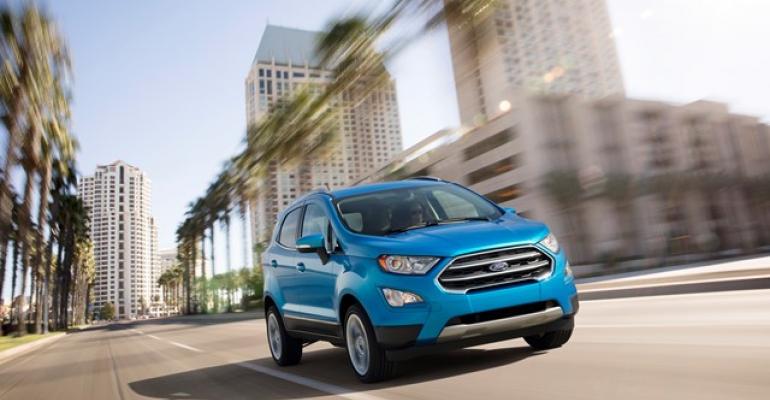Ford will cut car nameplates and options in favor of more profitable trucks and SUVs, slash product-development time and embrace electrification and partnerships as the Dearborn automaker prepares for what it calls “an evolving and disruptive period for the auto industry.”
Those are some of the high points of an investor presentation by Ford Tuesday after a 100-day review of the company’s strengths and operational fitness following the May 22 elevation of Jim Hackett to president and CEO, replacing Mark Fields. Hackett, a former Steelcase executive, previously led Ford Smart Mobility.
Acknowledging the leadership switch “was more about the future than the past,” Hackett says the automaker must change and evolve to be successful going forward.
“When you’re a long-lived company that has had success over multiple decades – hundreds of years – the decision to change isn’t easy,” Hackett says. “The mandate here is that Ford must compete.”
Ford’s stock price was nearly unchanged following the presentation, closing Wednesday at $12.30 per share on a day when the market was essentially flat.
Although the 2-hour presentation and question-and-answer session with analysts is light on specifics, Hackett outlines the broad strokes of a strategy to achieve an 8% annual profit margin by reducing complexity, speeding decision-making and rapidly evolving to build smart vehicles for new transportation systems.

Hackett emphasizes Ford’s healthy balance sheet, but his financial objectives include trimming costs by 2022 through adoption of advanced engineering and design techniques to save $4 billion and slashing $10 billion in material costs. Some $500 million saved from reducing internal-combustion engine architectures from 17 to 12 will be added to a previously announced plan to invest $4.5 billion in engineering electrified vehicles.
A significant reduction in vehicle ordering combinations – a tenfold decrease in ordering options on the next-generation Escape and, in the most extreme example, from 35,000 on the current Fusion sedan to just 96 on the next-generation model – will reduce complexity and save money.
Advanced design and engineering tools, such as the use of Microsoft’s HoloLens technology to reduce the number of prototype builds, is expected to cut vehicle development time 20%, while virtual engineering of assembly lines will slash plant changeover time 25%.
Taking a page from FCA CEO Sergio Marchionne’s playbook, Hackett says Ford will shift $7 billion away from cars and into development of trucks and SUVs, adding the Ranger and EcoSport in 2018 and the all-new Bronco in 2020.
Global marketing chief Jim Farley emphasizes ramped-up spending on utility vehicles will be market-focused, with more off-road-capable SUVs for the U.S., larger 7-seaters for China and urban utilities for Europe. Attention also is on building commercial-vehicle business, with a particular emphasis on how those vehicles factor into mobility plans for moving people and goods.
Ford still will offer cars, but at lower volumes and in more uplevel trims in the U.S. and Europe, Farley says. Hybrid and plug-in hybrids will share body styles with their ICE counterparts as the company works to build a sustainably profitable electric-vehicle business that includes offering less-expensive battery-electric vehicles developed by partners Mahindra in India and Zotye in China.
Connectivity will play a role in helping Ford achieve its objectives with Marcy Klevorn, president-Mobility, taking charge of the company’s myriad mobility and connected-vehicle partnerships and projects.
Plans call for providing connectivity in all new Ford vehicles sold in the U.S. by 2019 as part of a push to have connectivity built in to 90% of new Ford vehicles sold globally by 2020. Connectivity is expected to enable services related to everything from real-time traffic management to smart parking to autonomous-vehicle use.
“Ford was built on the belief that freedom of movement drives human progress,” Hackett says. “It’s a belief that has always fueled our passion to create great cars and trucks. And today, it drives our commitment to become the world’s most trusted mobility company, designing smart vehicles for a smart world that help people move more safely, confidently and freely.”
[email protected] @bobgritzinger





